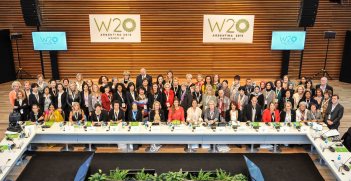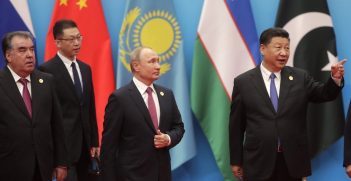Digital Disruption in Development

At a recent EU-Australia Digital Development Seminar, experts from Australia and the EU came together to discuss digital technology as a powerful driver of social and economic development around the world.
Digital moves quickly and we need to move quickly too if we are going to embrace the transformative power of technology in all its compelling applications, for the simple reason that harnessing this power can make the world a better place.
In developing countries, the inventive use of technology can provide communities with the skills and expertise to mitigate the impact of and withstand conflict and disaster. We know that the lack of skills and resilient workforces are drivers of displacement and migration following conflict. Technology can also be used to build the skills of displaced populations.
Driving education
For example, Facebook, Google and Microsoft among other tech giants recently joined forces with World Vision at a summit in Jordan to thrash out digital solutions for the education crisis facing more than 6 million displaced Syrian children. The use of mobile apps, video learning, tablet-based literacy tools, online courses, educational games, remote teacher-training, online assessments and teacher monitoring tools for Syrian refugee children were all on the table.
This is of profound significance in the context of war, which can turn the clock back generations, particularly in terms of children’s education. People go from living secure lives comparable to those we are privileged to enjoy in Australia, to living in tents relying on rations with little or no access to schooling. How can we educate children in these conditions?
All the education gains made in Syria over the past decade have been wiped out, according to the United Nations. One in three Syrian schools have been damaged. Their homes and schools may have been destroyed, but technology could be the gateway that lets Syrian children catch up on years of lost education.
I look forward to seeing how schooling is delivered digitally to refugee children over coming months and years; the education of this generation of children is of vital importance to future peace and leadership in the Middle East.
Where there’s smoke
Technology can also be used to save lives. World Vision is piloting a unique fire alarm in Bangladesh, called the Lumkani.
Slum fires kill thousands every year and entrench many more in poverty when, without insurance, people lose homes, businesses and even identification documents. High density slums are tinderboxes, with their mix of flammable materials, exposed wiring, and smoky open fires. Over 800 million live in slums worldwide, including 500 million in Asia.
What kind of fire alarm will work in these situations? The Lumkani fire alarm combines two key innovations. Firstly, it detects rapid rises in heat, rather than smoke, which is critical in smoky slum environments where open fires are used for heating, cooking and lighting. The detection of rapid heat sets off an alarm within the household. Secondly, a signal is sent to all other detectors within a 60-metre radius, along with phone text messages, to alert the surrounding community.
Part of running the pilot in Dhaka involves developing a sustainable implementation model that World Vision can replicate across Asia, potentially protecting millions. However, one of the challenges we face is unrolling technology at a scalable level to see and measure results.
Overcoming constraints
The widespread dispersion of information communications technology (ICT) also has important benefits for micro, small and medium enterprises in developing countries. Through new and traditional forms of ICT, small business people have greater opportunities to expand their businesses, grow their customer base and access critical market information, new innovations, new production technologies and finance. Women entrepreneurs are especially likely to benefit from the ways that ICT can overcome constraints when it comes to accessing finance, skills and training.
All too often, countries see a two-speed economy for digital solutions. The availability of technology often grows at uneven rates. In my view, it works best when the actual embedding of digital into development programming runs at the pace of infrastructure.
Non-government organisations (NGOs) can also leverage technology to improve their own data and better track people’s participation in programs. The transformation of digital within NGOs is just as important as transforming developing societies into digital natives, and probably the fastest way to see real change.
World Vision’s Livelihoods Academy, for example, is an online learning model to assist small business people in developing countries. It works by capturing the learnings of field-based staff from across its development programming around the world. World Vision partnered with Dynamind eLearning to design an award-winning Project Model Accredited Learning and Support (PALS) approach that promotes peer-to-peer learning and coaching.
The PALS approach is constantly evolving based on participant input. Using the Moodle platform, it supports World Vision field staff working directly with communities. So far over 300 certified staff have supported more than 200,000 smallholder farmer households to increase their economic resilience.
Governance
Technological development is also changing how people engage with governments. Like other NGOs, World Vision is establishing the best uses of technology to enable communities to participate in democratic processes and hold governments to account. Our program model, Citizen Voice and Action, mobilises and equips citizens to monitor government services. So far, we’ve seen how this can improve relationships between citizens, governments and service providers, resulting in the better delivery of health and education. All these things contribute towards the well-being of children.
Digital is also changing how NGOs communicate with their donors. It is more direct and real, and we need to keep up. This is critical when it comes to building people-to-people links around the world.
Because digital moves so fast, it’s clear that courage, rather than caution, is required. We must fearlessly explore the good, bad and ugly when it comes to digital technology. Especially as a sector, traditionally cautious not-for-profit organisations need to recognise that it is ok to fail sometimes; provided we are rigorous in the learning we glean from these failures.
Digital is transforming the aid landscape in ways that we couldn’t have anticipated even ten years ago; let’s embrace it and relish that we live in exciting times that mean when it comes to finding innovative solutions to many of the world’s problems, the sky, literally, is no longer the limit.
Claire Rogers is the CEO of World Vision Australia.
Claire was co-chair of the EU-Australia Leadership Forum’s Sectoral Policy Workshop on Digital Development held on 28 March. The EUALF is a three year program to broaden and deepen existing ties between the EU and Australia. The Australian Institute of International Affairs (AIIA) is part of the consortium selected to deliver the project and the AIIA’s National Director Melissa Conley Tyler is team leader. For more information visit https://europeaustraliaforum.eu/ and sign up for regular updates.
This article is published under a Creative Commons Licence and may be republished with attribution.





